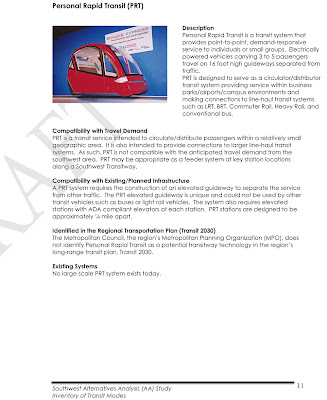However, Cybertran's supporters are not all progressives.
Allen Payton is CEO, and Vice Chairman of the Board of eTranzUSA , a partner (PDF) and promoter of Cybertran. On April 27, 2010, Payton showed a video to the City Council of Brentwood, California which voted in favor of a resolution "authorizing the Mayor or designee to send a letter to the Chairperson of the U.S. House of Representatives, Transportation and Infrastructure Committee in support of a funding application for CyberTran International Inc. light rail transit system" ((PDF)). Allen Payton also left comments about Cybertran on an article about Skytran and an article about PRT in Mountain View, California and another article about PRT. More comments from Payton about Cybertran on this forum.
Besides, being an enthusiastic PRTista, Allen Payton is a staunch, right-wing Republican. Lisa Vorderbrueggen at the Political Blotter in this 2008 post, recounts briefly the colorful political career of Allen Payton. Some highlights:
Payton was the man behind an anonymous hit-piece on Freitas that arrived in Antioch mailboxes just prior to the mayor’s 2004 re-election. Some pointed the finger at Davis but Payton eventually admitted that he was the author.
Payton has political baggage, too.He served on a deeply dysfunctional City Council from 1994-1998 and barely survived a 1996 recall campaign. Payton abandoned plans in 2000 to run for mayor after he was arrested in an domestic dispute involving his wife.
But regardless of his political challenges, Payton faces an even steeper uphill climb as a write-in candidate. As the title suggests, a write-in candidate must persuade voters to physically write down his or her name on the ballot. That takes a lot of motivation.
The post includes a comment from Payton "correcting" the info about the anonymous hit-piece, saying he was not the author. Payton claimed he was the fall guy for the episode.
A September 16, 1998 San Francisco Chronicle article titled "Antioch Councilman Paying Fine / $72,000 penalty stems from false business ads" has more details about Payton:
The district attorneys of Marin and Sonoma counties filed suit earlier this year in Marin County Superior Court against Payton and his wife, Donna, accusing them of making unfounded claims in flyers and radio ads about the benefits of Fatbusters, a weight-loss program that includes herbal supplements. There was no scientific basis for saying that Fatbusters can "curb your appetite" or "literally shrink and melt away the fat," prosecutors alleged.
Payton complains that the decision to fine him for false advertising was an example of over-regulation. More details about Payton's klassy style in campaigning:
Payton faces another lawsuit for flyers he sent out during the 1996 City Council campaign.
Losing candidate Michael Clement's slander suit against Payton accuses him of saying falsely that Clement shirked his taxes and once greeted police who came to his property at gunpoint. Payton says his statements were within the bounds of free speech and has asked a judge to dismiss the case.
Payton, a Republican stumped for John McCain in Florida in 2008. Payton also donated a total of $2,000 to McCain in 2007. Robert Chew, Vice President of eTranzUSA contributed a total of $6,900 to McCain in 2008.
Payton was also part of Meg Whitman's failed effort to win the 2010 gubernatorial election in California.
Like a lot of Republicans, Payton likes to say nasty stuff about gay people - one of his tweets says:
"CA Democrats advance 'lesbians-as-role models' plan http://j.mp/eLTB7t - while the state continues to face a $26 billion deficit. VETO!"
and this tweet:

The following photo below from the eTranz Facebook (link) Photo shows Allen Payton and Bob Chew sitting inside a silly Cybertran model.

Previous posts on Cybertran:
Cybertran Defined by Pod Promoters as Personal Rapid Transit
Tragic Waste of Taxpayers' Dollars on Gadgetbahn in Richmond, California



